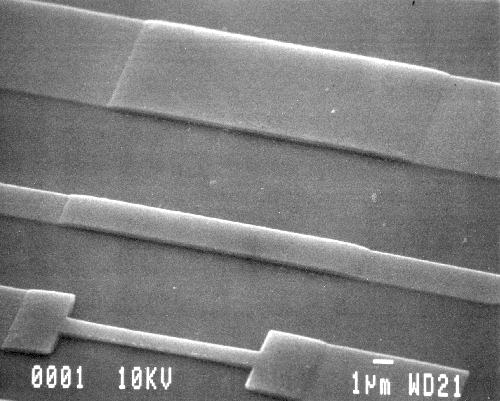NPGS:
Free
Standing
Picture Menu | Main
Menu
 The strips are
free-standing aluminum that is ~100 nm thick. First, ~0.5 um of negative
resist was spun onto a silicon substrate. The negative resist was then
patterned to have a strip 15 um wide with registration marks spaced around
it. (Note that the registration marks simply consisted of the patterned negative
resist.) After developing the negative resist, ~0.5 um of PMMA was spun
on. The NPGS alignment feature was used to accurately align to the
registration marks made of negative resist that were under 0.5 um of
PMMA! The strips shown here were then patterned in the PMMA. After
aluminum was evaporated and lifted off, an oxygen plasma was used to remove
the negative resist from underneath the aluminum, thus leaving the structures
free standing above the silicon surface.
The strips are
free-standing aluminum that is ~100 nm thick. First, ~0.5 um of negative
resist was spun onto a silicon substrate. The negative resist was then
patterned to have a strip 15 um wide with registration marks spaced around
it. (Note that the registration marks simply consisted of the patterned negative
resist.) After developing the negative resist, ~0.5 um of PMMA was spun
on. The NPGS alignment feature was used to accurately align to the
registration marks made of negative resist that were under 0.5 um of
PMMA! The strips shown here were then patterned in the PMMA. After
aluminum was evaporated and lifted off, an oxygen plasma was used to remove
the negative resist from underneath the aluminum, thus leaving the structures
free standing above the silicon surface.
This work was done in Dr. Martin Wybourne's research lab when he was at the
University of Oregon.
Copyright (c) 1996 JC Nabity Lithography Systems. All rights
reserved.
 The strips are
free-standing aluminum that is ~100 nm thick. First, ~0.5 um of negative
resist was spun onto a silicon substrate. The negative resist was then
patterned to have a strip 15 um wide with registration marks spaced around
it. (Note that the registration marks simply consisted of the patterned negative
resist.) After developing the negative resist, ~0.5 um of PMMA was spun
on. The NPGS alignment feature was used to accurately align to the
registration marks made of negative resist that were under 0.5 um of
PMMA! The strips shown here were then patterned in the PMMA. After
aluminum was evaporated and lifted off, an oxygen plasma was used to remove
the negative resist from underneath the aluminum, thus leaving the structures
free standing above the silicon surface.
The strips are
free-standing aluminum that is ~100 nm thick. First, ~0.5 um of negative
resist was spun onto a silicon substrate. The negative resist was then
patterned to have a strip 15 um wide with registration marks spaced around
it. (Note that the registration marks simply consisted of the patterned negative
resist.) After developing the negative resist, ~0.5 um of PMMA was spun
on. The NPGS alignment feature was used to accurately align to the
registration marks made of negative resist that were under 0.5 um of
PMMA! The strips shown here were then patterned in the PMMA. After
aluminum was evaporated and lifted off, an oxygen plasma was used to remove
the negative resist from underneath the aluminum, thus leaving the structures
free standing above the silicon surface.